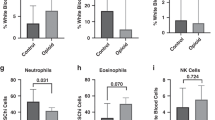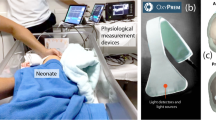Abstract
Objectives
We constructed reference intervals for end-tidal carbon monoxide (ETCOc) levels of neonates 28 0/7 to 34 6/7 weeks gestation in order to assess hemolytic rate.
Study design
This is a prospective four-NICU study in Bangkok, Thailand, and Utah, USA.
Results
Of 226 attempted measurements, 92% were successful. Values from day 1 through 28 were charted and upper (>95th percentile) reference interval limits calculated. During the entire 28 days, the ETCOc upper reference intervals from babies in Bangkok were higher than those in Utah (p < 0.01). No differences were found due to sex, or earliest vs. latest gestation at birth (both p > 0.1). Similar to term neonates, preterm neonates in Bangkok and Utah had higher ETCOc values during the first 48 h after birth than thereafter (p < 0.01).
Conclusions
Using this methodology, and the reference interval chart, the hemolytic rate of preterm infants ≥28 weeks can be assessed.
This is a preview of subscription content, access via your institution
Access options
Subscribe to this journal
Receive 12 print issues and online access
$259.00 per year
only $21.58 per issue
Buy this article
- Purchase on SpringerLink
- Instant access to full article PDF
Prices may be subject to local taxes which are calculated during checkout

Similar content being viewed by others
Code availability
The computer code used for statistical analysis is available by request from the corresponding author.
References
Maisels MJ, Pathak A, Nelson NM, Nathan DG, Smith CA. Endogenous production of carbon monoxide in normal and erythroblastotic newborn infants. J Clin Invest. 1971;50:1–8.
Stevenson DK, Fanaroff AA, Maisels MJ, Young BW, Wong RJ, Vreman HJ, et al. Prediction of hyperbilirubinemia in near-term and term infants. J Perinatol. 2001;21:S63–72. Discussion S83-7
Tidmarsh GF, Wong RJ, Stevenson DK. End-tidal carbon monoxide and hemolysis. J Perinatol. 2014;34:577–81.
Maisels MJ, Kring E. The contribution of hemolysis to early jaundice in normal newborns. Pediatrics. 2006;118:276–9.
Christensen RD, Lambert DK, Henry E, Yaish HM, Prchal JT. End-tidal carbon monoxide as an indicator of the hemolytic rate. Blood Cells Mol Dis. 2015;54:292–6.
Castillo Cuadrado ME, Bhutani VK, Aby JL, Vreman HJ, Wong RJ, Stevenson DK. Evaluation of a new end-tidal carbon monoxide monitor from the bench to the bedside. Acta Paediatr. 2015;104:e279–82.
Bhutani VK, Wong RJ, Vreman HJ, Stevenson DK, Jaundice Multinational Study Group. Bilirubin production and hour-specific bilirubin levels. J Perinatol. 2015;35:735–8.
Christensen RD, Malleske DT, Lambert DK, Baer VL, Prchal JT, Denson LE, et al. Measuring end-tidal carbon monoxide of jaundiced neonates in the birth hospital to identify those with hemolysis. Neonatology. 2016;109:1–5.
Bhutani VK, Srinivas S, Castillo Cuadrado ME, Aby JL, Wong RJ, Stevenson DK. Identification of neonatal haemolysis: an approach to predischarge management of neonatal hyperbilirubinemia. Acta Paediatr. 2016;105:e189–94.
Christensen RD, Yaish HM. Hemolysis in preterm neonates. Clin Perinatol. 2016;43:233–40.
Bhutani VK, Maisels MJ, Schutzman DL, Castillo Cuadrado ME, Aby JL, Bogen DL, et al. Identification of risk for neonatal haemolysis. Acta Paediatr. 2018;107:1350–6.
Bhatia A, Chua MC, Dela Puerta R, Rajadurai VS. Noninvasive detection of hemolysis with ETCOc measurement in neonates at risk for significant hyperbilirubinemia. Neonatology. 2020;117:612–8.
Christensen RD, Agarwal AM, George TI, Bhutani VK, Yaish HM. Acute neonatal bilirubin encephalopathy in the State of Utah 2009-2018. Blood Cells Mol Dis. 2018;72:10–3.
Du L, Ma X, Shen X, Bao Y, Chen L, Bhutani VK. Neonatal hyperbilirubinemia management: clinical assessment of bilirubin production. Semin Perinatol. 2021;45:151351.
Teng C, Wondka T, Christensen RD. Infant birth weight and tidal volume compatibility of the CoSense ETCO monitor. Baltimore, MD: Pediatric Academic Societies Meeting; 2016.
Bahr TM, Henry E, Christensen RD, Minton SD, Bhutani VK. A new hour-specific serum bilirubin nomogram for neonates ≥35 weeks of gestation. J Pediatr. 2021;20:S0022–3476(21)00489-3.
Geraci M, Bottai M. Linear quantile mixed models. Stat Comput. 2014;24:461–79.
Watchko JF. Bilirubin-induced neurotoxicity in the preterm neonate. Clin Perinatol. 2016;43:297–311.
Kitai Y, Hirai S, Okuyama N, Hirotsune M, Mizutani S, Ogura K, et al. Diagnosis of bilirubin encephalopathy in preterm infants with dyskinetic cerebral palsy. Neonatology. 2020;117:73–9.
Pillai A, Pandita A, Osiovich H, Manhas D. Pathogenesis and management of indirect hyperbilirubinemia in preterm neonates less than 35 weeks: moving toward a standardized approach. Neoreviews. 2020;21:e298–e307.
Arnold C, Tyson JE, Pedroza C, Carlo WA, Stevenson DK, Wong R, et al. Cycled phototherapy dose-finding study for extremely low-birth-weight infants: a randomized clinical trial. JAMA Pediatr. 2020;174:649–56.
Okumura A, Ichimura S, Hayakawa M, Arai H, Maruo Y, Kusaka T, et al. Neonatal jaundice in preterm infants with bilirubin encephalopathy. Neonatology. 2021;19:1–9.
Hansen TWR, Maisels MJ, Ebbesen F, Vreman HJ, Stevenson DK, Wong RJ, et al. Sixty years of phototherapy for neonatal jaundice – from serendipitous observation to standardized treatment and rescue for millions. J Perinatol. 2020;40:180–93.
Morris BH, Oh W, Tyson JE, Stevenson DK, Phelps DL, O’Shea TM, et al. Aggressive vs. conservative phototherapy for infants with extremely low birth weight. N Engl J Med. 2008;30:1885–96.
Arain Y, Banda JM, Faulkenberry J, Bhutani VK, Palma JP. Clinical decision support tool for phototherapy initiation in preterm infants. J Perinatol. 2020;40:1518–23.
Bahr TM, Shakib JH, Stipelman CH, Kawamoto K, Cail K, Lauer S, et al. Improving the bilirubin management program in the newborn nursery: background, aims, and protocol. Neonatology. 2020;117:358–64.
Bahr TM, Shakib JH, Stipelman CH, Kawamoto K, Lauer S, Christensen RD. Improvement initiative: end-tidal carbon monoxide measurement in newborns receiving phototherapy. J Pediatr. 2021;S0022-3476:00673-9.
Sanpavat S. Exchange transfusion and its morbidity in ten-year period at King Chulalongkorn Hospital. J Med Assoc Thai. 2005;88:588–92.
Jirapaet K. Thai healthy newborns have a higher risk. J Med Assoc Thai. 2005;88:1314–8.
Wouda EMN, Thielemans L, Darakamon MC, Nge AA, Say W, Khing S, et al. Extreme neonatal hyperbilirubinaemia in refugee and migrant populations: retrospective cohort. BMJ Paediatr Open. 2020;28:e000641.
Maisels MJ, Pathak A, Nelson NM. The effect of exchange transfusion on endogenous carbon monoxide production in erythroblastotic infants. J Pediatr. 1972;81:705–9.
Strocchi A, Schwartz S, Ellefson M, Engel RR, Medina A, Levitt MD. A simple carbon monoxide breath test to estimate erythrocyte turnover. J Lab Clin Med. 1992;120:392–9.
Author information
Authors and Affiliations
Contributions
SP: conception and design, collection and assembly of data, data analysis and interpretation, manuscript writing, editing and final approval of manuscript. TRC: collection and assembly of data, data analysis and interpretation, manuscript writing, editing and final approval of manuscript. TMB: conception and design, collection and assembly of data, data analysis and interpretation, manuscript writing, editing and final approval of manuscript. EG: conception and design, collection and assembly of data, editing and final approval of manuscript. MJS: conception and design, collection and assembly of data, editing and final approval of manuscript. KSC: collection and assembly of data, data analysis and interpretation, editing and final approval of manuscript. S. Supapannachart: conception and design, collection and assembly of data, editing and final approval of manuscript. PN: conception and design, collection and assembly of data, editing and final approval of manuscript. S. Sukwiset: conception and design, collection and assembly of data, editing and final approval of manuscript. RKO: conception and design, collection and assembly of data, data analysis and interpretation, editing and final approval of manuscript. RDC: conception and design, collection and assembly of data, data analysis and interpretation, manuscript writing, editing and final approval of manuscript.
Corresponding author
Ethics declarations
Competing interests
CoSense End Tidal CO monitors and Precision Sampling Sets were provided by Capnia, Inc, Foster City, CA, USA. None of the authors has any conflict of interest.
Additional information
Publisher’s note Springer Nature remains neutral with regard to jurisdictional claims in published maps and institutional affiliations.
Rights and permissions
About this article
Cite this article
Pakdeeto, S., Christensen, T.R., Bahr, T.M. et al. Reference intervals for end-tidal carbon monoxide of preterm neonates. J Perinatol 42, 116–120 (2022). https://doi.org/10.1038/s41372-021-01207-2
Received:
Revised:
Accepted:
Published:
Issue date:
DOI: https://doi.org/10.1038/s41372-021-01207-2
This article is cited by
-
Erythrokinetic mechanism(s) causing the “late anemia” of hemolytic disease of the fetus and newborn
Journal of Perinatology (2024)
-
A “Gold Standard” Test for Diagnosing and Quantifying Hemolysis in Neonates and Infants
Journal of Perinatology (2023)



